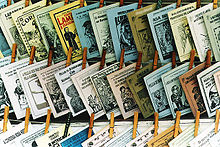- Cordel literature
-
Cordel literature (from the Portuguese term Literatura de cordel, literally "string literature") are popular and inexpensively printed booklets or pamphlets containing folk novels, poems and songs, which are produced and sold in fairs and by sidestreet vendors in the Northeast of Brazil. They are so named because they are hung from strings in order to display them to potential clients. They form one of the least altered continuations of the Western traditions of popular literature, such as chapbooks, and popular prints. This genre of literature was also found in Spain during the 18th and 19th centuries, and offered readers a wide array of topics, from basic instruction to political tracts.
They are usually produced in black and white, in quarto format, and are illustrated with woodcuts. They come from the papel volante tradition of Portugal. The cordel literature found its zenith in the decades of 20s and 30s, with the popular legend created by the cangaceiros of Lampião, a band of outlaws and bandolier bandits who terrorized the region for almost 20 years. The War of Canudos, a military conflict in the state of Bahia, 1896-1897, has been also a frequent theme of cordel literature, due to its epic dimensions and importance for the history of the Northeast backlands.
Some of the main authors from the past are Leandro Gomes de Barros (1865-1918)[1] and João Martins de Athayde (1880-1959).
There are a lot of not-well-known cordel authors in Brazil, although there are still chapbooks that tell widely known old tales, even reivented, in a new context. See as an example a masterpiece of the past decades: "A Chegada de Lampião no Inferno" (The Arrival of Lampião in Hell) by José Pacheco, as well as today's "A Chegada de Lula no Inferno" (The Arrival of Lula in Hell); besides "classics", living folk poetry say to us much both about cordel and its strong roots in the day-to-day life of the people and its place in the Brazilian Culture as a whole. Two expressive woodcutters are Adir Botelho and Jose Francisco Borges, whose woodcuts have been exhibited in the Louvre and the Smithsonian.
Cordel Literature can still be found in the Northeastern states, most notably in Pernambuco, Paraiba and Ceara.
Notes
External links
- Biblioteca Cordel On-Line (in Portuguese)
- Tesoros Trading Company reprint of New York Times article about Jose Borges(in English)
- Academia Brasileira de Literatura de Cordel (Portuguese)
- Literatura de Cordel do Brasil (in Portuguese)
Categories:- Brazilian literature
- Printmaking
- Printmaking stubs
Wikimedia Foundation. 2010.

